While Russia and Iran don’t always concur, their status as pariahs of the West has pushed them to work as an “axis of the sanctioned.” One way this has materialized is through the International North-South Transport Corridor (INSTC), a 7,200-kilometer network of road, rail, and shipping routes designed to move freight between India, Iran, Azerbaijan, Russia, Central Asia, and Europe.
Conceived in 2000 but never finished, the INSTC is increasingly being viewed by both countries as a solution to Western isolation. The question now is whether it can be built.
A problem for strategic planners on both sides is that the trade corridor would pass through Azerbaijan – which the Islamic Republic has threatened to destroy.
Indeed, relations between the neighboring Shia nations have grown tense in recent months, as both countries have held military drills along the Aras River, which separates Iran from Azerbaijan and Armenia.
And yet, pragmatism may nonetheless prevail. In September, Iran’s foreign ministry called the INSTC “crucial” for regional economic activity, and this month, following a tripartite meeting in Turkey, Iranian Parliament Speaker Muhammed Bakir Kalibaf said “some misunderstandings with the Republic of Azerbaijan have …disappeared recently.”
Baku, for its part, would benefit economically from the INSTC, and according to President Ilham Aliyev, infrastructure work related to the transport corridor in Azerbaijan has been completed.
Once operational, “15 million to 30 million tons of cargo can be transported from the territory of Azerbaijan through the [INSTC] alone,” Aliyev said.
Moscow and Tehran have committed significant resources to making the transport corridor a reality.
Officials recently discussed completion of the Astara-Rasht-Qazvin railway, a transport corridor that will connect existing railways of Russia, Azerbaijan, and Iran to the INSTC. Overall, Moscow and Tehran plan to invest as much as $25 billion in the regional network.
Some aspects of the project are already moving.
For instance, this month Russia and Iran signed a contract for construction of a cargo ship to operate out of the Caspian Sea port of Solyanka, in the southern Russian city of Astrakhan. This suggests that the two countries aim to build not only the land route, but also to strengthen the Caspian transportation network.
Russia and Iran have also discussed the creation of a transport-logistics hub in Iran’s Bandar Abbas port, while the topic of Caspian Sea cooperation was on the agenda for a meeting this week between the countries’ foreign ministers.
Moscow likely views a land link with Iran as a better investment – given that Western countries control most major sea routes and have imposed restrictions on Russian ships.
Nonetheless, the Kremlin is keeping its options open. Earlier this month, Russian President Vladimir Putin and his Iranian counterpart agreed on the need for “consistent implementation of mutually beneficial projects in the energy, transport, and logistics sectors,” according to a readout of the call.
If completed, the INSTC would help Russian and Iranian companies reorient to eastern markets, circumventing some of the sanctions that are strangling their operations.
But creating a new transport route is far from guaranteed; there are plenty of obstacles that continue to stand in the way of an operational corridor.
For starters, it remains uncertain whether Russia, despite being one of the major protagonists, can guarantee security on its section of the transportation route.
The Russian government plans to build roads around Khasavyurt and Derbent – strategically important cities located in Dagestan, a restive region that has faced waves of anti-government protests.
If Moscow loses in Ukraine, separatist tendencies in Dagestan, where ethnic Russians make up only 3.6 percent of the population, will undoubtedly grow, impacting the fate of the INSTC.
Second, given the current geopolitical circumstances, it’s unlikely that European nations will use Russia and Iran as transit routes to India. In a similar vein, the successful functioning of the INSTC would depend on whether Asian countries, namely India and the Gulf states, would agree to do any serious business along transit hubs managed by Russia and Iran.
Third, it will take time to build the necessary transport infrastructure, and it’s unclear whether Moscow, struggling with Western sanctions and bogged down in Ukraine, has the capacity to complete such ambitious projects.
Finally, the United States and its allies can always find new ways to prevent Moscow and Tehran from completing their endeavor – through more sanctions, sabotage, or other means.
At this point, the obstacles to a fully functional INSTC appear insurmountable. Thus, Russia and Iran will likely focus more on developing closer bilateral ties – be it in the fields of aviation or aerospace – aware that a regional transport corridor is heavily dependent on other regional actors.
While a trade route to bypass Western sanctions will remain high on agendas in Moscow and Tehran, for now, the INSTC appears more aspirational than possible.
(This is an opinion piece and the views expressed above are the author’s own. The Quint neither endorses nor is responsible for the same. This article was published in an arrangement with Syndication Bureau.)
